Defining the Metaverse
Technically the original vision and definition of The Metaverse was a point in time when the blurring of a distinction between physical and digital happens. This has typically been thought of in the context of AR (Augmented Reality) and VR (Virtual Reality) otherwise known as Mixed Reality becoming ubiquitous.
However, we believe it’s important we think of it not as a destination but a journey or process.
This is because it’s important to acknowledge the beginnings of the Metaverse are already here and if we think of it as a far off destination we will sleep walk into not addressing some fundamental design choices and potentially replicate or deepen what is broken about the Web today.
It seems one of the defining characteristics of a metaverse was that somehow it was an economic system independent of, and enjoys supremacy to, old fiat based economies controlled by nation states.
If we look at Facebook’s efforts to launch its own digital currency with Libra (which would have extended to Oculus), because it is a highly centralised and fiat based company, it has been aggressively constrained and in effect neutered as a genuine disruptive and sovereign crypto-currency.
It could be considered partially true some games platforms are so big they are closed micro-economies, with their own currencies which they control centrally and value systems, like experience points systems, in-game items (skins) and marketplaces, where significant amounts of the wealth are held and traded.
But the reality is only a few even let you transact in and out of their closed platform using fiat but even more importantly, wealth is not directly transferable between these microeconomics into a virtual meta economy with its own sovereign currencies.
What’s more you can’t generally borrow against virtual wealth to buy physical assets, putting digital natives at an economic disadvantage, where 63% of gamers said they would actually spend more on skins if they had real world value.
We propose ultimately we believe the defining characteristic of a true Metaverse is that it needs its own economy and currencies native to it, where value can be earnt, spent, lent, borrowed or invested interchangeably in both a physical or virtual sense and most importantly without the need for a government.
Competing Multiverses
However, in the paper we first explore two versions of The Metaverse we observe emerging: one dominated by closed platforms and Big Tech like Facebook / Oculus and the other built on open protocols leveraging blockchains like Decentraland. Where its possible to assess the degree of comparative openness across;
how much a platform embraces open source principles with their code and data, how closed a virtual economy is (within / across their proprietary games), the extent they control the monetary & fiscal policy of underlying economy, how it interacts with fiat based systems, and if they allow transferability of value outside their ecosystem. We also believe there is a Low-fi vs Hi-Fi spectrum based on the hardware required to experience a virtual world which we propose should continue to be maintained in order to be as inclusive and onboard as many people out of the old economy and into The Open Metaverse.
Web 3, a stack for an Open Metaverse
We lay out the idea that there are a set of convergent technologies which allow for a common operating system for an Open Metaverse that sit between the hardware, application software and user. And because of it’s open source characteristics and on-chain transferability of assets through NFTs, makes digital assets and their metadata persistent and perpetual. In this sense The Open Metaverse OS makes the virtual worlds that build on it in part or as a whole pregnant with important Web 3 principles around user centricity, decentralisation and sovereignty which creates an unstoppable nature to its success.
The Web 3 Toolbox
We breakdown exactly how Web 3, its design principles, protocols and standards form a toolbox for the entrepreneurs & architects in the Metaverse which we describe as The Web3 Toolbox for The Open Metaverse, and propose they will become interchangeable terms, increasingly being understood to be one and the same thing.
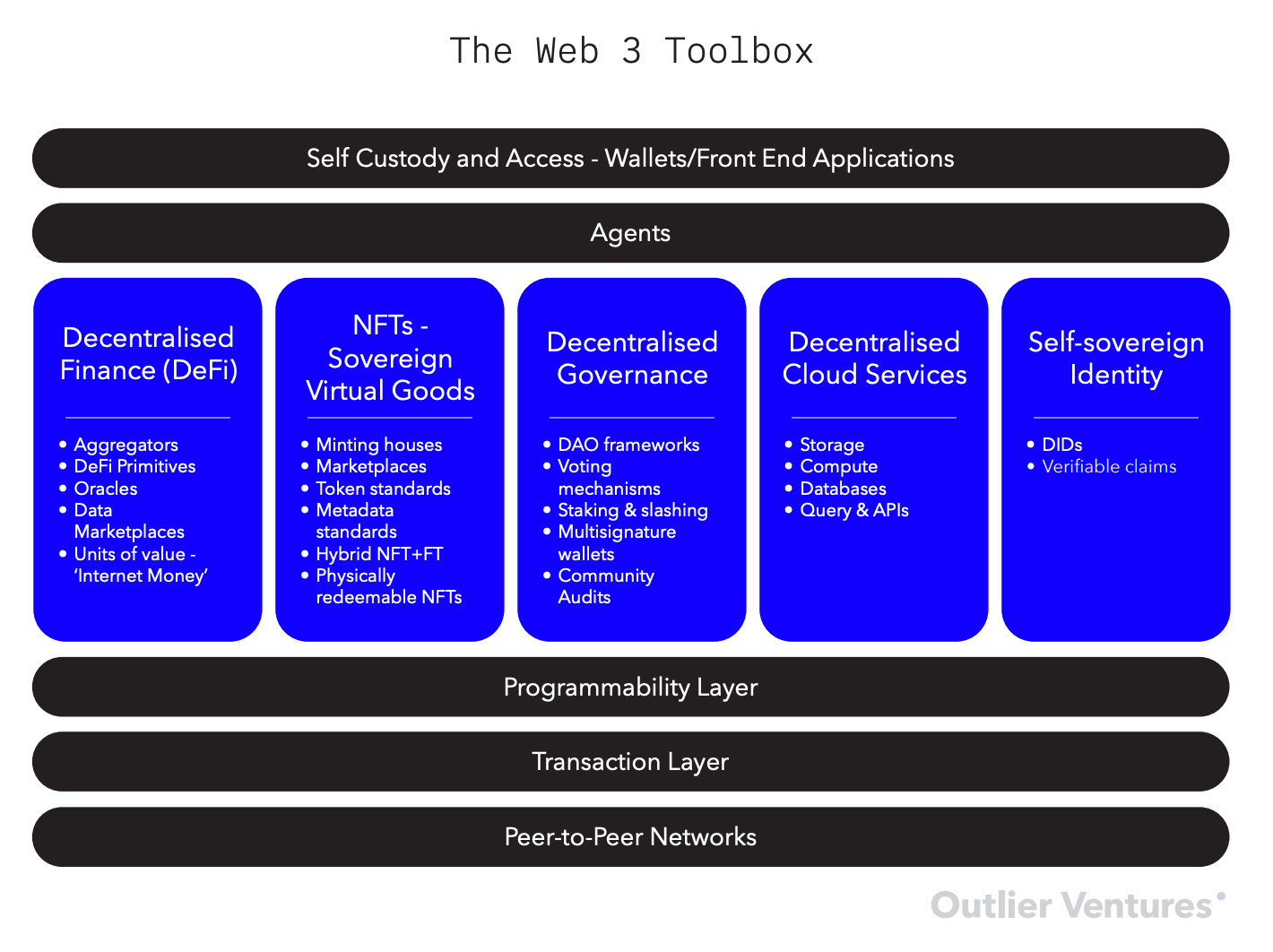
Building in the Metaverse
We propose were you to be using this toolbox to build an entirely new instance within the Metaverse (such as a virtual world), or looking to evolve an existing Web 2 platform, you would be presented with a set of design decisions and trade-offs at several levels of your stack between open / shared or closed / gated and proprietary. And that you might reasonably elect for an open solution at one level and closed at another either permanently or temporarily based both on the immediate needs of your business and its stakeholders (like shareholders), users or a philosophical principle. In the end there will always be a tension to be imperfectly resolved.
We propose a way to approach this is to look at the anatomy of any given instance of the metaverse as a platform at its various levels of the stack using a consistent framework which we called The Anatomy of a Virtual World.
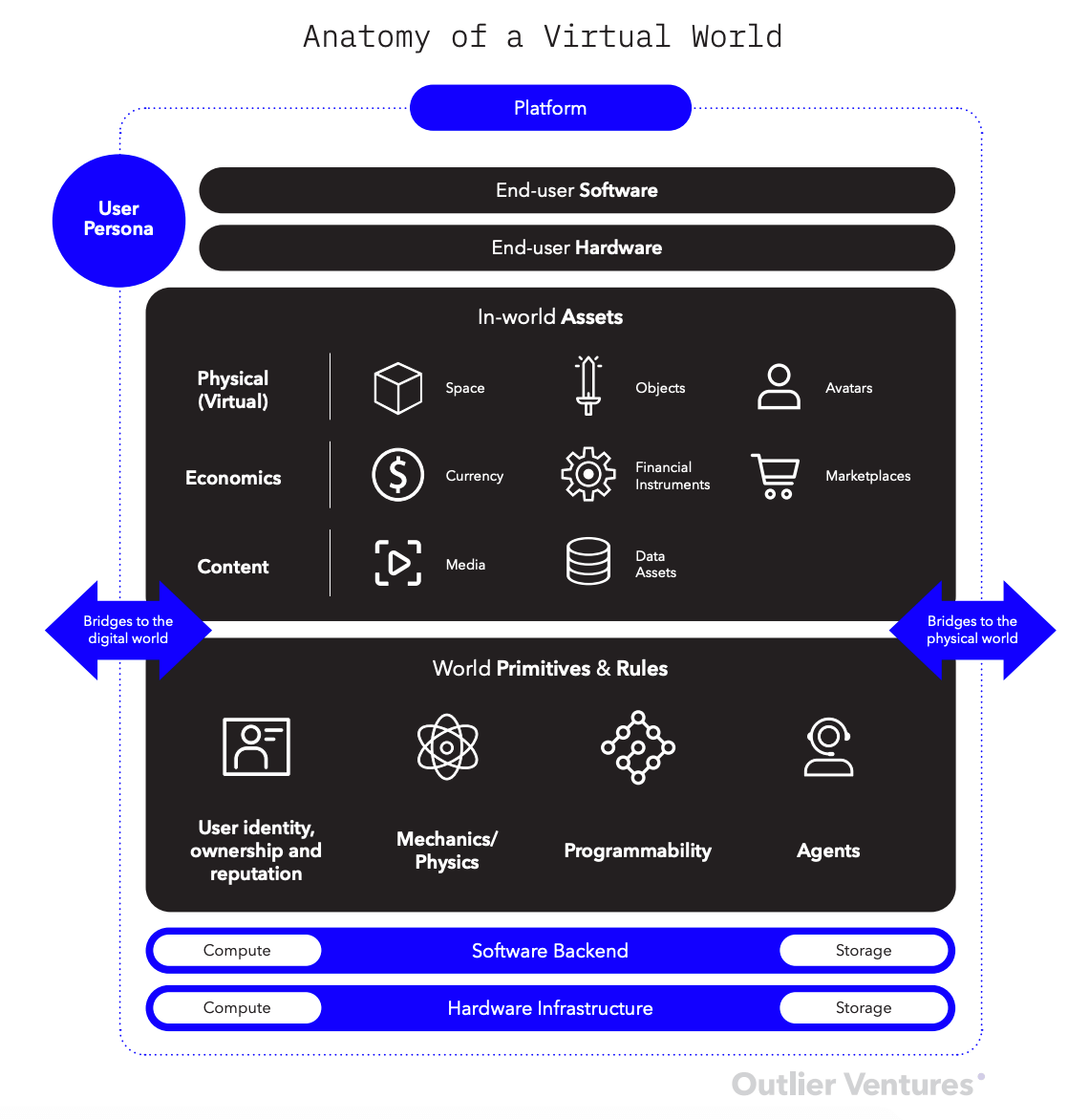
The Open Metaverse OS
We address the question: is the Open Metaverse OS ready for prime time? With our view being that Web 3 technology has been optimised primarily for high degrees of decentralisation and transaction security rather than and sometimes at the expense of enabling smooth, real-time interactions. And its applications for more 2D web based experiences on desktops and mobiles. As a consequence user experience in Web 3 to date has to date been poor but that this is changing as increasingly the world of Web 3 and crypto is it’s self converging with new environments like gaming and VR there is a generational shift away from Web 2 platforms.
We propose therefore The Open Metaverse OS is best understood as an evolving collection of highly composable technologies that will increasingly, but selectively, be used to make aspects of a the Metaverse progressively more open.
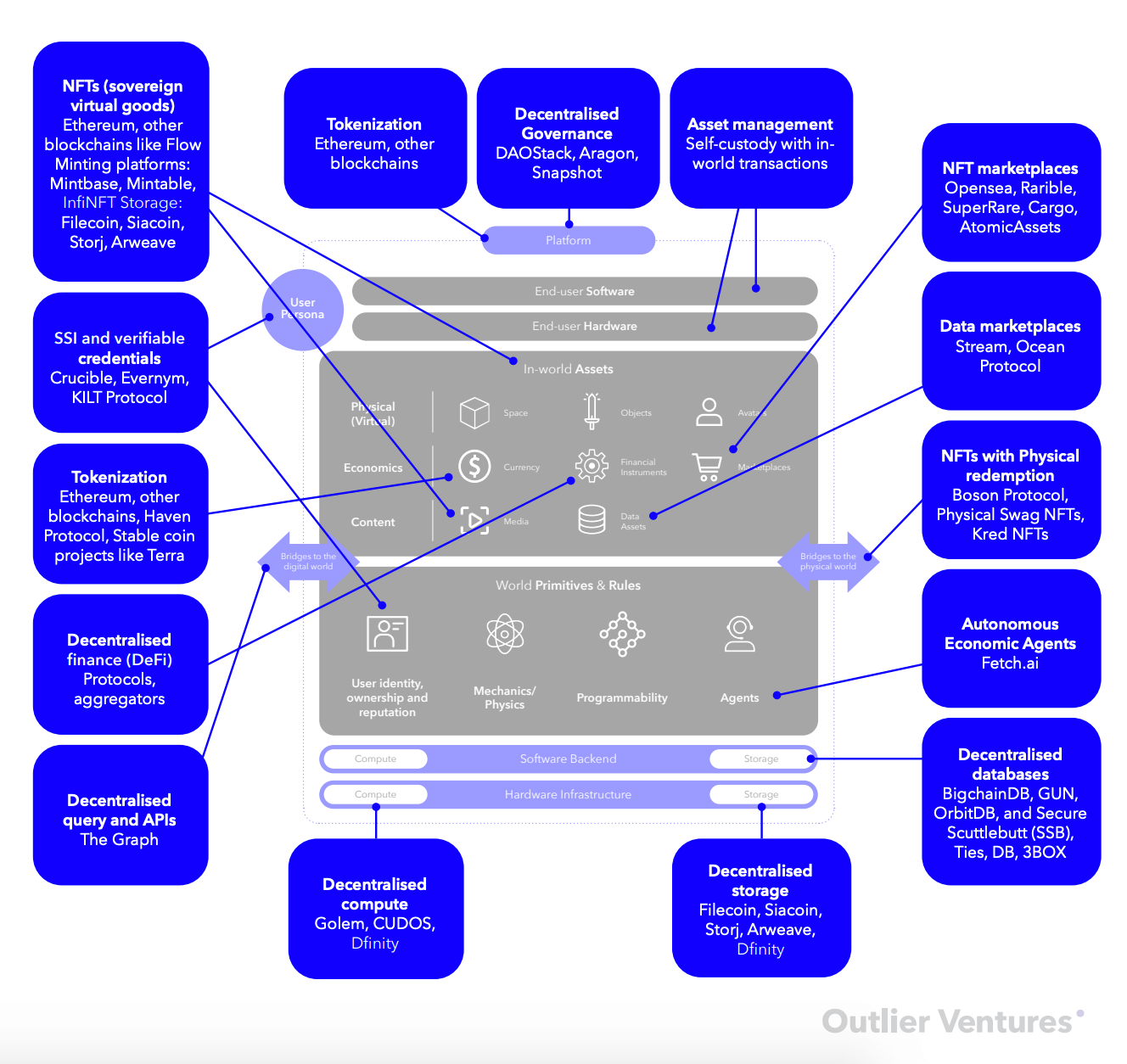
An Openness Framework
We suggest a way of thinking about an Open Metaverse OS is also as a framework through which to assess the openness or otherwise, design choices and trade-offs made by a given instance of the metaverse including such as; is the code open source, are the assets portabile, is the data platform proprietary or user controlled, who can create value, and the degree of UGC vs platform made and how can it be monetized.
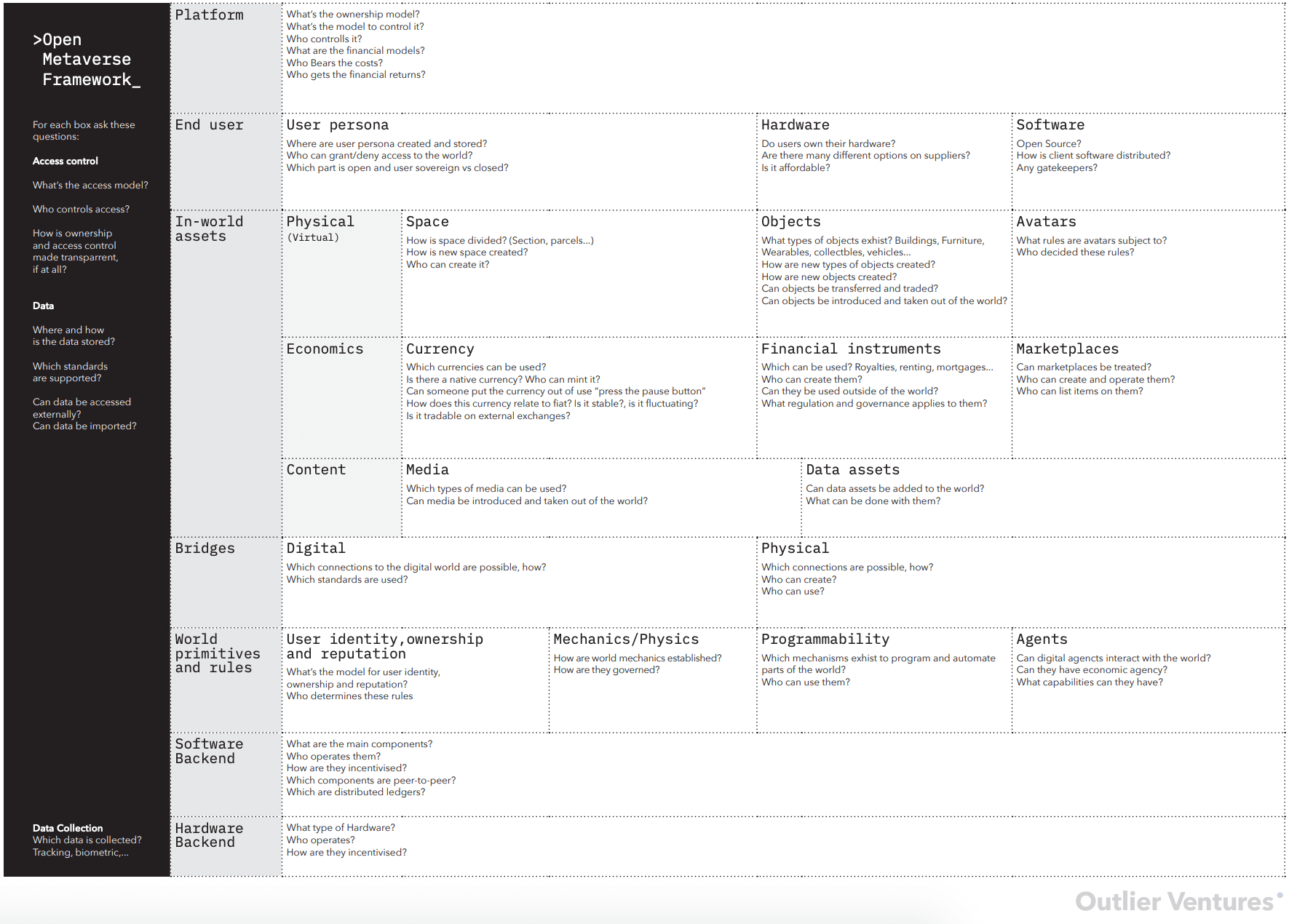
We find it important to stress throughout, like ‘decentralisation’, it is unlikely openness is absolute and its choices are not binary but rather on a spectrum. And even within those virtual worlds and platforms, we could classify as the most ‘open’ there will be significant nuance, often driven by technical limitations both of being an early adopter as well as dependencies on underlying protocols like Ethereum which require workarounds for improved usability comprising what happens on-chain, impacting ‘openness’.
So why build in the Open Metaverse?
We address why even build or integrate a virtual world or good with The Open Metaverse OS at all? Especially, when compared to a more convenient closed and centralised approach, with so many trade-offs and limitations to mass adoption?
We explain why we believe there is a general direction of travel towards open standards in The Metaverse even by what you might at first glance regard as it’s closed participants with Open 3D object media standards: and Metaverse Web Browsers.
We explore the importance of principles of self sovereignty, sovereignty of identity and associated digital wealth (including assets and increasingly data) based on the concept of user centricity: where a user takes precedence over any given platform. Where some may argue the user in aggregate is the platform. In this context we believe virtual worlds become the interface to create, trade or experience virtual goods and services which are portable and not restricted to a single platform.
And propose this is a powerful economic driver and a fundamental paradigm shift away from the Closed Metaverse and its business models we see dominate the Web today. When creations, wealth and assets can have a life ‘off platform’ and be exchanged and become infinitely interchangeable with one another, freely in open markets, they grow in liquidity and consequently value, simply because more value can be exchanged between itself without limitation. Something we propose you could consider as a form of ‘value squared’.
We suggest we can also regard different virtual worlds, open or closed, as slices of a larger whole. Where users can and will by design interact with and be part of one or more of these worlds. And whilst a single world could outgrow all others and become a significant part of The Multiverse they do not enjoy the same defensible ‘moats’ seen in Web 2 of locking users and their data into their platforms and holding them ransom.
Therefore we explain it is more likely virtual worlds in The Open Metaverse are increasingly interoperable and interconnected to the point it will be hard to distinguish them as separate but just rather different instances of a whole.
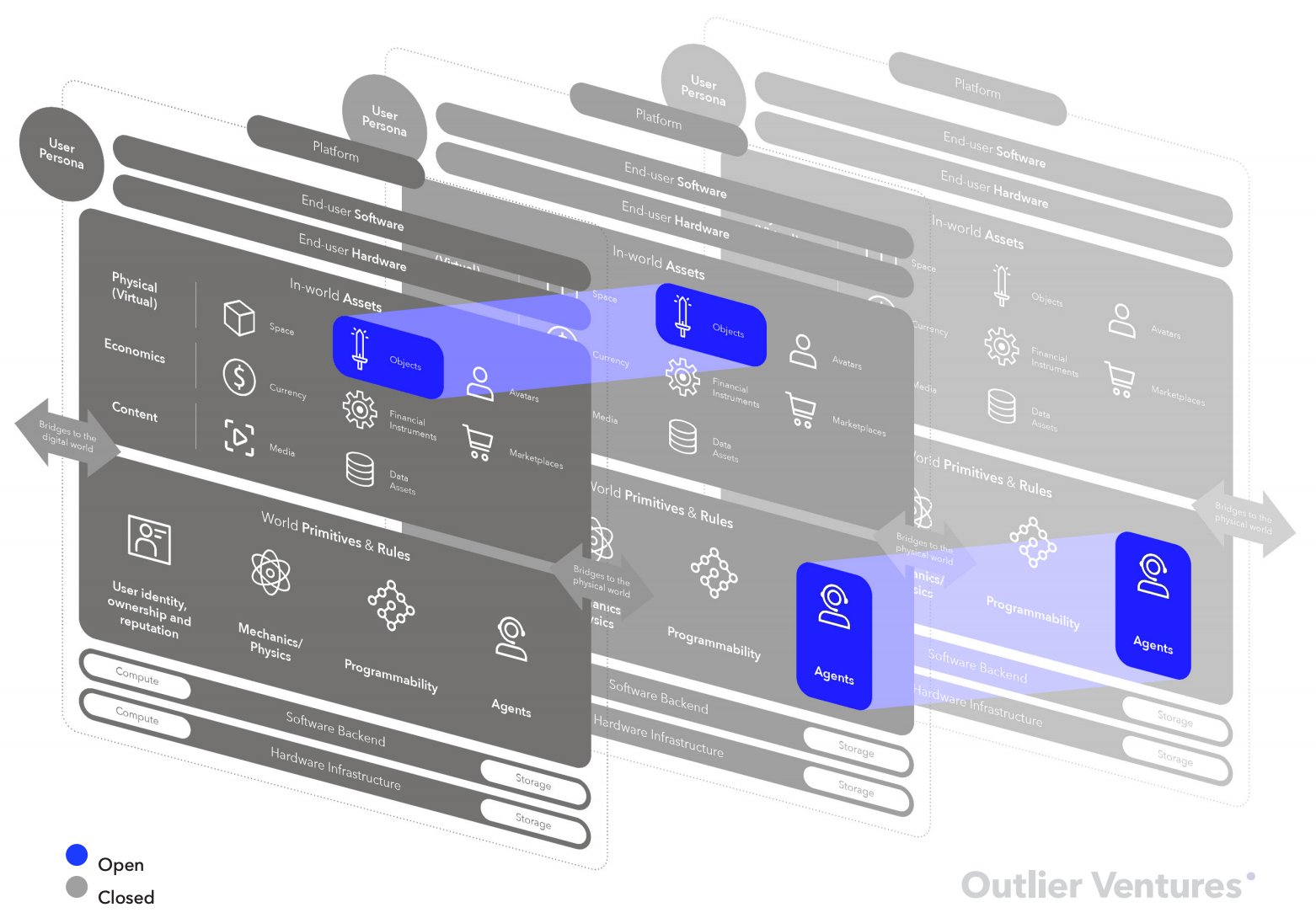
The empty world problem
We also address that when comparing The Open Metaverse to its closed cousin that it is largely full of empty worlds. The number of daily active users across all platforms is still estimated to be in the low thousands and is almost irrelevant when compared with Fortnite alone which has 350m+ monthly users.
We ask the question how can open virtual worlds first catch up and equal the content and rich experiences of today’s dominant virtual world and gaming platforms? And propose in the same way crypto-currency exchanges like Coinbase and Binance brought crypto generally to millions of retail investors through the sale and exchange of ERC20s and ICOs in 2017 driving media attention and a virtuous hype cycle so will NFT platforms only much more so.
As well as how LiDAR technology which now allows anybody with the latest iPhone, to mass render the physical world, translate it into machine readable 3D models and convert them into tradable NFTs which could be uploaded into open virtual worlds very quickly populating them with avatars, wearables, furniture, and even whole buildings and streets.
And how because they machine readable they can leverage open source standards like Pixar’s USD, NVIDIA’s MDL, Khronos Group and NVIDIA’s Omniverse to further be fed into AI to spit out infinite variations which again can be better monetised in global and open markets than any one closed platform.
We discuss why we believe this will dramatically reduce the time and cost to produce games or whole virtual worlds and economies whilst also tapping into a global workforce of millions of creators allowing seamless and decentralised collaboration well beyond the capabilities of a single gaming studio, record label or virtual platform.
Humanity’s greatest economic experiment
We propose The Open Metaverse, pregnant with Web 3 principles, will allow innovators to experiment in an open and permissionless experiment with its underlying economics, as well as the rules of the game that underpin it both at the protocol layer but also within each virtual world itself. And that each experiment can be done in parallel to the other; in concert and / or direct competition.
We discuss how this can create entirely new wealth in a purely virtual sense but which puts bread on the table and roofs over people’s heads. And whilst play-to-earn is nothing new it is now going mainstream where ‘play as work’ and innumerable variations including; hold to play, share or curate to earn and play for keeps, could become the primary income for hundreds of millions of people as a form of financial emancipation rather than digital feudalism.
Top down regulatory forces
Finally, we address in combination an increasing top down mandate by governments to limit the power of social platforms like Facebook and other various Web 2 platform monopolies from an antitrust perspective but also from a Data Trade and abuse motive create an additional and powerful force to unbundle platforms.
And that once regulators come to terms with what cryptocurrencies mean and the impact to their fiat-based economies will be, in the end, they will realise their success is both inevitable but also beneficial bringing about a form of open, permissionless hyper-competition both technically but also in financial services and inclusion which are undoubtedly in the interests of consumers.
However, we warn The Open Metaverse can not be misunderstood to be a panacea for the world’s ills nor a utopia without its problems.
In Conclusion
We invite you to read the full paper and feedback back to us your thoughts and consider this paper as a first pass at trying to make sense of the Metaverse. We look forward to discussing and iterating on it with you and would like to thank and acknowledge all of the contributors that helped us arrive at this initial understanding.
Finally, we look forward to seeing you in the Metaverse; and hopefully an increasing more open one!
JB
Download the full report